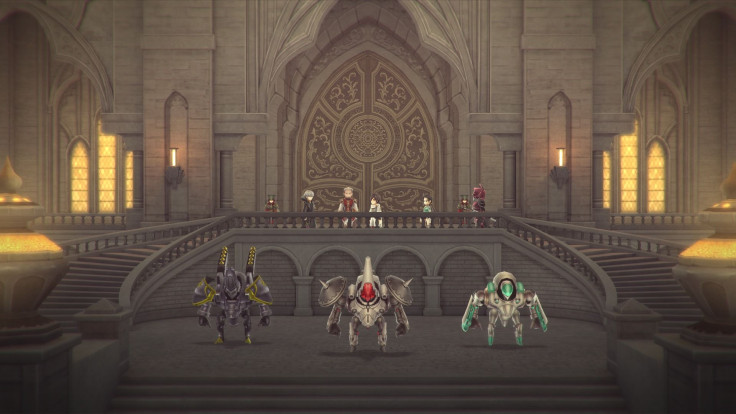The successor to Tokyo RPG Factory’s I Am Setsuna, Lost Sphear brings players to a world where people and locations mysteriously vanish, fading into white nothingness. Only Kanata, aided by his loyal companions, can utilize the power of memories to return things to normal.
As do so many great RPGs, Lost Sphear begins with a teen oversleeping in his humble peasant village. The game hews to the familiar, time-tested JRPG formula: turn-based combat with melee attacks and magic spells, journeying to new towns and dungeons, acquiring new party members, discovering the fate of the world is at stake. There’s item shops with flask signs outside, and sparkly save points hint there’s a boss battle in the next room.
Throughout, the game tips its cap in reverence to old-school classics of the genre: here a riff on iconic Final Fantasy VI locations like Narshe and Vector, there a nod to Chrono Trigger’s combat and world map. Major plot points also flash back to those games, with a dash of Xenogears and FFVII thrown in. It’s only after playing a few hours that you realize that the comparisons invited by all these similarities aren’t particularly flattering, because little about Lost Sphear’s characters, setting or story stands out as memorable until quite late in the game.
There’s a snarky, mysterious guy with silver hair. A reluctant hero whose strongest weapon is the power of friendship. A spunky girl with animal ears and sass to spare. You’ve seen more interesting versions of these characters before, in Final Fantasy, Dragon Quest, Tales, Star Ocean, Lunar and so on. (There’s even a Locke, but he doesn’t hold a candle to FFVI’s gentleman thief.) Simple animated cutscenes or character portraits might have helped Lost Sphear’s narrative and cast feel more distinctive, but with so much of the dialogue feeling completely interchangeable, you’ll be mashing that fast-forward button like there’s no tomorrow.

I struggled to care about the first half, maybe even two-thirds, of Lost Sphear’s story. Major “twists” are either obviously telegraphed for several hours, or simply come out of nowhere. When Lost Sphear plays its big dramatic cards and echoes classic scenarios, like the ‘Time Egg’ arc in Chrono Trigger or navigating Cloud’s subconscious in FFVII, I found myself swept up in nostalgia for those games rather than immersed in the one I was actually playing. That said, the fourth quarter holds some genuine treats that redeem some of the earlier tedium. I won’t spoil them here, though I did come away with a slightly more positive impression toward the end than I had midway through.
On a brighter note, Lost Sphear’s strategically rewarding magic and combat systems keep the turn-based battles consistently fast-paced and (mostly) fun. Equipping Spiritnite lets you customize your magical skills and attacks, adding supplementary buffs, healing or status effects, so your party members feel a lot more distinctive in combat than they do in conversation. Some skills will require a cooldown of a couple turns, encouraging you to think out each character's strategy a few rounds in advance.
Combat will keep you engaged throughout, offering chances to score preemptive attacks and potential bonus effects with well-timed button presses. If you need a little time to breathe, you can set the battle system to semi-active, preventing enemies from attacking while you’re navigating menus. But even with that option selected, the action can feel unnecessarily hectic at times, with baddies often getting cheap shots in during split-second intervals as you toggle between options. This can lead to a few controller-flinging moments, particularly given the enormous difficulty jump between regular enemies and bosses. You may be flying through dungeons one-shotting baddies with the greatest of ease, but you will get your ass handed to you with extreme prejudice by bosses on normal difficulty, more than once. It’s nothing a temporary tweak to easy mode can’t fix, but it’s an annoying design choice nonetheless.

Partway through the game you'll also gain the option to equip your party in mechanical armor known as Vulcosuits, an appealing idea that ends up being a bit of a dud. In battle, the suits don't make your teammates that much stronger, and they weirdly lack standard melee attacks, severely limiting their appeal. After repeatedly finding myself forced to waste turns because I was stuck waiting for a skill cooldown and couldn't do anything in my fancy robot armor, I mostly stopped using the Vulcosuits unless the game forced me to do so.
All in all, Lost Sphear is a mixed bag that will appeal to some RPG fans more than others. If you’re less invested in plot and can't get enough crazy-hard boss fights, you’ll enjoy it more than I did. Granted, the story does pick up in the home stretch, but Lost Sphear takes too long to deliver the goods.
- Spiritnite system
- fast-paced combat
- a fun late-game plot twist
- story and characters mostly uninteresting
- crazy difficulty jumps
- cash always in short supply



















